
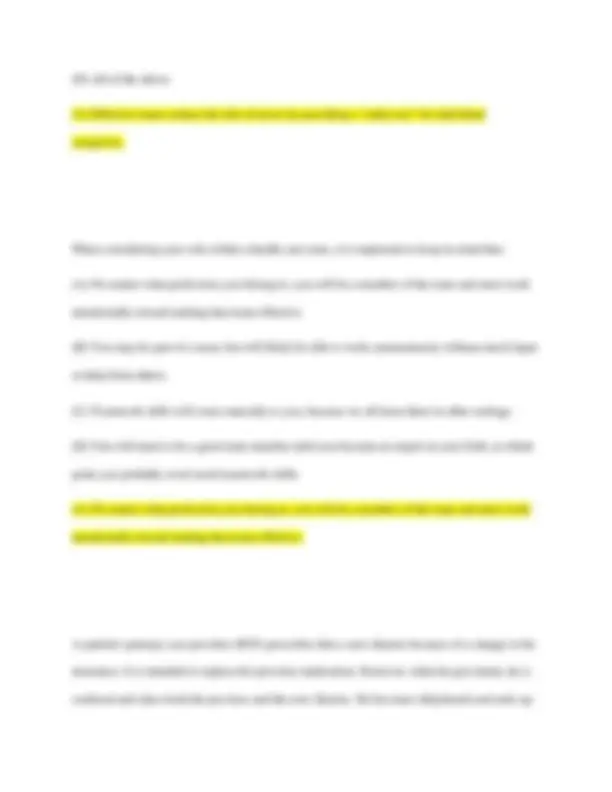
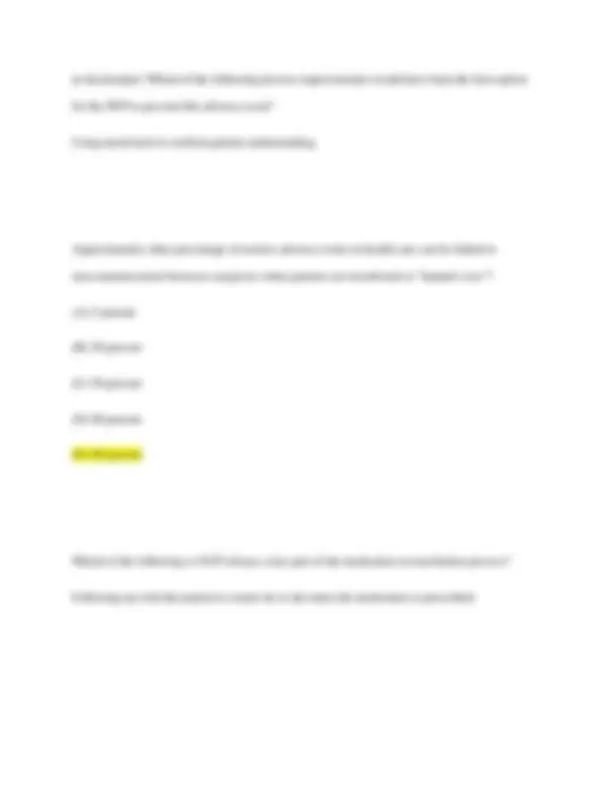
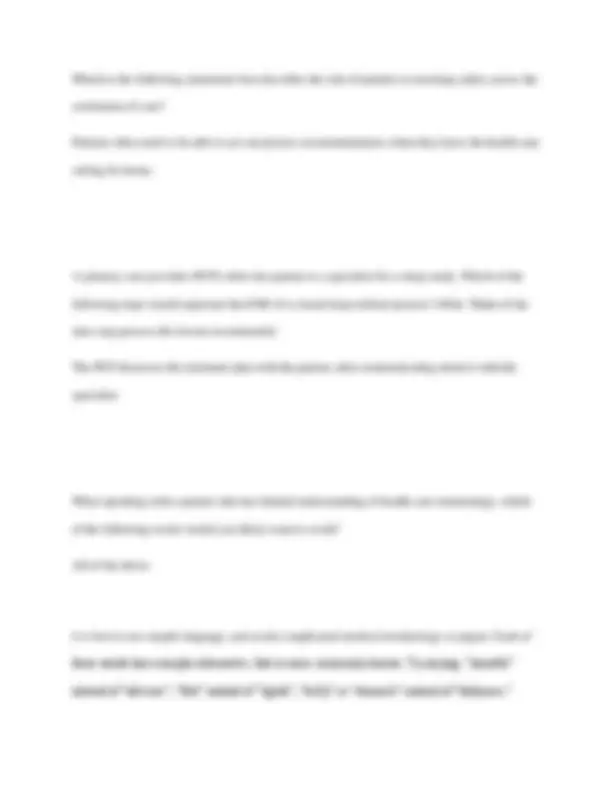

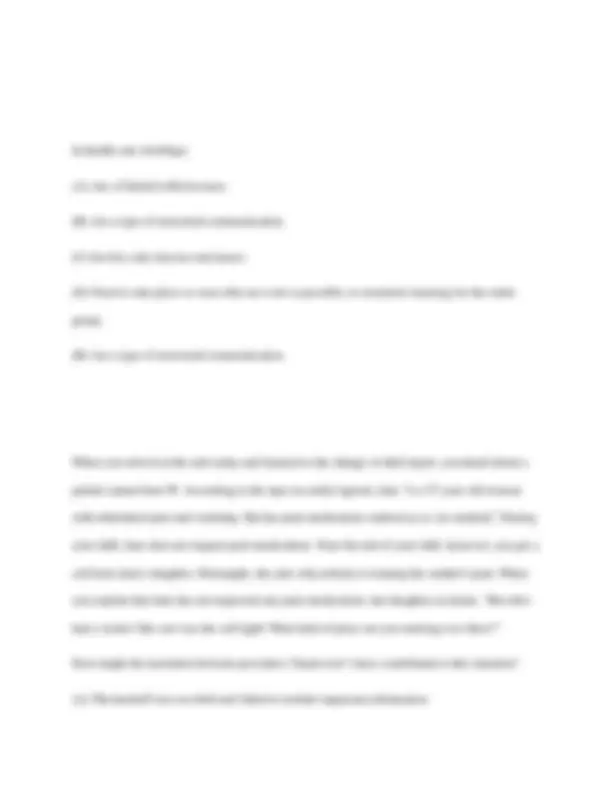
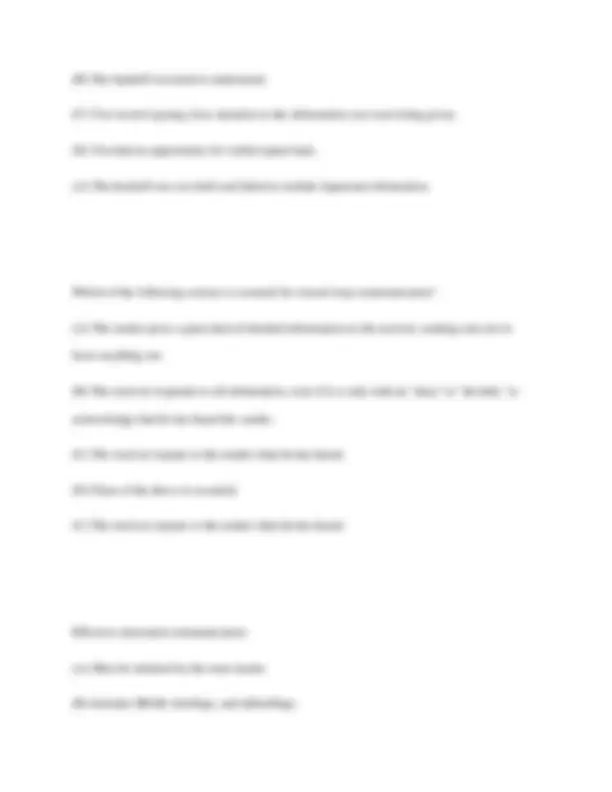


Study with the several resources on Docsity

Earn points by helping other students or get them with a premium plan


Prepare for your exams
Study with the several resources on Docsity

Earn points to download
Earn points by helping other students or get them with a premium plan
Community
Ask the community for help and clear up your study doubts
Discover the best universities in your country according to Docsity users
Free resources
Download our free guides on studying techniques, anxiety management strategies, and thesis advice from Docsity tutors
A series of multiple-choice questions and answers related to the importance of effective healthcare teams. It explores key characteristics of effective teams, including communication, teamwork, and the role of individual members. The document also highlights the significance of structured communication methods like sbar, briefings, and debriefings in improving patient safety and preventing errors. It emphasizes the importance of clear communication and collaboration among healthcare professionals to ensure optimal patient care.
Typology: Exams
1 / 11

This page cannot be seen from the preview
Don't miss anything!







Effective health care teams have several important characteristics, including:
(A) The ability to rehearse procedures together, like a choir or a sports team.
(B) Stable membership; that is, they have the same people on the team from day-to-day.
(C)
Effective communication techniques.
(D) The ability to achieve good results without strong communication.
(C) Effective communication techniques.
Which of the following is likely to be the most immediate result of building an effective health care team?
(A) Less costly health care
(B) Safer care
(C) Fewer delays in care
(D) Elimination of waste in the system
(B) Safer care
As a nurse practitioner in a small, rural urgent care clinic, you believe that your clinic team works well together. Which of the following facts would best support your belief?
(A) Not a single complaint about unprofessional behavior has been filed by clinic members over the past year.
(B) The providers work in rotating shifts and rarely need to transmit information from one shift to the next.
(C) The team routinely takes a moment to discuss the plan and voice concerns before doing a procedure.
(D) All of the above.
(C) The team routinely takes a moment to discuss the plan and voice concerns before doing a procedure.
One reason it's critical for caregivers to improve their teams' effectiveness is:
(A) Effective teams reduce the risk of errors by providing a "safety net" for individual caregivers.
(B) Effective teams limit the number of caregivers patients have to speak with, reducing confusion among patients and families.
(C) Teams rely less on technology and more on human capabilities, thus leading to better care.
in the hospital. Which of the following process improvements would have been the best option for the PCP to prevent this adverse event?
Using teach back to confirm patient understanding
Approximately what percentage of serious adverse events in health care can be linked to miscommunication between caregivers when patients are transferred or "handed-over"?
(A) 5 percent
(B) 20 percent
(C) 50 percent
(D) 80 percent
(D) 80 percent
Which of the following is NOT always a key part of the medication reconciliation process?
Following up with the patient to ensure he or she takes the medication as prescribed
Which is the following statements best describes the role of patients in ensuring safety across the continuum of care?
Patients often need to be able to act out precise recommendations when they leave the health care setting for home.
A primary care provider (PCP) refers her patient to a specialist for a sleep study. Which of the following steps would represent the END of a closed-loop referral process? (Hint: Think of the nine-step process this lesson recommends)
The PCP discusses the treatment plan with the patient, after communicating about it with the specialist.
When speaking with a patient who has limited understanding of health care terminology, which of the following words would you likely want to avoid?
All of the above
it is best to use simple language, and avoid complicated medical terminology or jargon. Each of these words has a simpler alternative, that is more commonly known. Try saying: “harmful” instead of “adverse”; “fats” instead of “lipids”; “belly” or “stomach” instead of “abdomen.”
ou are a member of an intensive care unit team in a regional hospital. This morning, a patient had an unexpected severe allergic reaction (anaphylaxis) after being given a penicillin derivative. There was a significant delay in getting the physician involved and beginning treatment for this life-threatening condition. Fortunately, the patient is now stable and does not seem to be experiencing any lasting effects.
At this point, what would an effective team leader do?
(A) Report this adverse event in the anonymous reporting system so that it can be investigated
(B) Ask administrators to launch an investigation immediately to find out who was responsible for this adverse event
(C) Add this medication to the patient's allergy list
(D) Conduct a debriefing
(D) Conduct a debriefing
ou are a member of an intensive care unit team in a regional hospital. This morning, a patient had an unexpected severe allergic reaction (anaphylaxis) after being given a penicillin derivative. There was a significant delay in getting the physician involved and beginning treatment for this
life-threatening condition. Fortunately, the patient is now stable and does not seem to be be experiencing any lasting effects.
The unit leaders are trying to figure out what changes they should make to prevent this treatment delay from happening again. Given what you know about the incident, what change would you recommend?
(A) Implement mandatory debriefings after the team works together on a patient.
(B) Fire the physician who failed to respond in a timely way.
(C) Stop using nursing assistants in the ICU.
(D) Implement the use of critical language in the ICU.
(D) Implement the use of critical language in the ICU.
Effective team leaders:
(A) Have multiple degrees.
(B) Are usually physicians.
(C) Seek input from all members of the team.
(D) Know the correct answer in any given situation.
(C) Seek input from all members of the team.
(B) The handoff was hard to understand.
(C) You weren't paying close attention to the information you were being given.
(D) You had no opportunity for verbal repeat back.
(A) The handoff was too brief and failed to include important information.
Which of the following actions is essential for closed-loop communication?
(A) The sender gives a great deal of detailed information to the receiver, making sure not to leave anything out.
(B) The receiver responds to all information, even if it is only with an "okay" or "uh-huh," to acknowledge that he has heard the sender.
(C) The receiver repeats to the sender what he has heard.
(D) None of the above is essential.
(C) The receiver repeats to the sender what he has heard.
Effective structured communication:
(A) Must be initiated by the team leader.
(B) Includes SBAR, briefings, and debriefings.
(C) Is more important for nurses than for physicians.
(D) Includes email, text messaging, and debriefings.
(B) Includes SBAR, briefings, and debriefings.